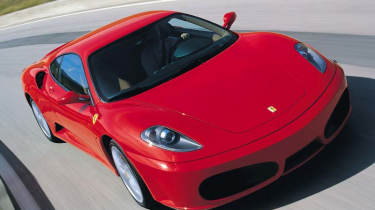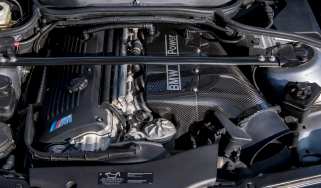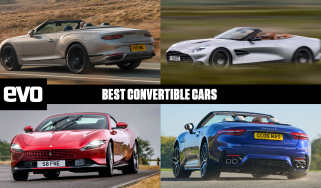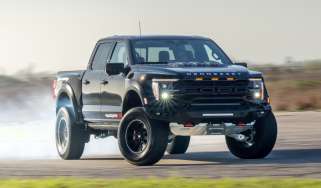Ferrari F430 v Lamborghini Gallardo: Bullfighting
If there's a car that the Ferrari F430 has to beat, it's Lamborghini's Gallardo
Having spent many more hours than we were strictly entitled to enjoying the F430 on everything from sweeping autostrada to sections of the classic Mille Miglia road race route, we now know that the F430 is a formidable achievement, the perfect embodiment of everything a modern Ferrari should be. What we don't know is how the F430 compares with the car that forced Ferrari to push so hard: the Lamborghini Gallardo. Which is why, precisely a week after boarding a Bologna-bound BA Boeing, Gus Gregory and I are back at Gatwick boarding another. Our mission: to collect an e-gear Gallardo from Sant' Agata and return to the self-same roads to complete the test that Ferrari really didn't want anyone to do but, as appears highly likely, everyone has. The F430 made a big impression on me last week. The tactility, the pliancy, the incisive, organic handling and yes, the sheer pace of the thing are not just a big step on from the 360 Modena but a big step on for Ferrari road cars full-stop. It would be easy, therefore, to make bold claims for the F430, claims that could come back to haunt us when the time comes to drive the two cars back-to-back on UK roads. And so, while driving the two cars a week apart isn't ideal, we're of the firm belief that given the choice between a full day in each car on the same roads in the same weather conditions but not on the same day, or a rushed hour-long rendezvous in which to grab a few driving impressions and photos, we'd take the former every time. How we make the photography work is a matter for Gus Gregory and art director Chee-Chiu Lee to worry about. It's with eager anticipation that we arrive to collect the Gallardo. Parked outside and finished in Lamborghini's trademark yellow, it looks like a chiselled hunk of sulphur smouldering in the October sunshine. Luc Donckerwolke's minimalist, graphic styling lends the Gallardo immaculate proportions which, to my eyes, make the F430 look a little fussy and truncated, but whatever your taste it's heartening that the two cars have such individual visual identities. Climbing into the Gallardo reveals an interior that conforms to the supercar norm. Low-slung, broad sills, hard seats and an intimidating view forwards, little visibility behind. Compared with the F430 it's a bit more confined, a little less airy. The pedals are similarly offset, forcing you to skew your hips in the seat, but the Gallardo's hard seats offer less lumbar support than the plump cushions in the Ferrari. It's a close call but the Ferrari edges it for ambience. You twist the ignition key in the Lamborghini rather than fingering a button, but the effect is no less memorable. The 5-litre V10 catches with a percussive boom and idles busily, filling the cockpit with a distinctive harmonic warble. As in the Ferrari, the Gallardo's e-gear transmission is actuated by fixed, column-mounted paddles. There's more mechanical noise associated with the gearshift in the Lamborghini, and the clutch has a harder time of getting the Gallardo underway than the F430. Perhaps it's something to do with the additional drag of the all-wheel-drive system, but if you need to pull out from a T-junction on an incline you can't help but wince in sympathy for the poor old clutch. Chuntering through the outskirts of Sant' Agata towards the autostrada reveals the Gallardo rides more stiffly at low speed. There's also more noise transmitted through the structure of the car, and this, coupled with the truculent edge to the transmission, makes the Gallardo a less accomplished urbanite. Once on the motorway, though, the Lambo limbers up a little. The iron-fisted damping makes more sense and there's plenty of weight to the steering. The self-centring is more consistent, but the feel isn't as detailed or natural as the Ferrari's, which isn't a great surprise as we've always said the Gallardo's helm is a little numb and aloof. What remains impressive is the engine, which offers instant acceleration despite throttle response that lacks the F430's snap. The Gallardo feels a heavier, more muscular machine on the move, backing up what the spec-sheet describes. At 1520kg the Gallardo is 70kg heavier than the F430, but it delivers 10bhp and 33lb ft of torque some 700rpm or so earlier than the more highly-strung Ferrari. The result is a set of on-paper performance figures that can barely be separated: the F430 hits 62mph in 4.0sec to the Gallardo's 4.1sec, Maranello claiming 'at least' 196mph for the F430 compared with Sant'Agata's 192mph for the Gallardo. And they call these entry-level models... What the spec sheets don't shed any light on is how the two cars achieve those figures, but as we point the Gallardo's sharply sculptured snout onto the foothills of the Futa Pass it soon becomes clear that what it lacks in livewire tactility it makes up for with unflinching traction and a less edgy, nose-led stance. Sure, understeer is less heroic, and ultimately a less entertaining trait, but we're not talking armfuls of plough-on scrub here, just a few degrees of confidence-inspiring, chassis-settling front-end slip. Of course, when you've had the option of adjusting the balance of your car with a switch on the steering wheel, the Gallardo's old-school method of telegraphing the limit of adhesion seems a bit low-tech, but when it comes to deploying a rampant 500bhp to the road as cleanly and safely as possible, all-wheel drive will always have an advantage over an E-Diff, no matter how clever. Driving hard in the Ferrari through combinations of fast, third-gear corners, you make regular corrections, balancing the tail-led stance with small but important nudges of corrective lock. It's not that the Ferrari is twitchy - far from it, in fact - but it manages to resist understeer so completely that when you begin to tease the limits of adhesion it's always the tail that's going to move. In the Gallardo you carry similar corner speed but with less effort. It's a less edgy experience that asks less of you as a driver. You have to try absurdly hard to overwhelm the rear end, for it simply won't budge unless you provoke it as you would a front-drive hot hatch. Do so and you'll find it handles predictably and exploitably. For this very reason, and despite the F430's multitude of manettino settings, I'd put my money on a determined Gallardo driver putting clear air between themselves and an F430 should rain enter the equation. The Ferrari's engine has a more impressive reach, but the electric exhaust note has lost some voltage compared with the 360's ear-splitting shriek. The extra capacity has tangibly bolstered the low and mid-range response, but taller gearing and a greater need for revs than the lustier Gallardo can sometimes work against the Ferrari in the cut-and-thrust of a twisty road. However, it counters with faster, cleaner, snappier upshifts and, when it fully hits its stride, a more emphatic top-end rush. The Gallardo's biggest weakness is under braking. True, the Ferrari's carbon-ceramic stoppers are a £10K option but, as many of the year's worth of orders already taken for the F430 include the brake upgrade, it's clear that Brembo's finest is regarded as must-have kit by the paying public. Were Lamborghini to offer customers this option too, I'm sure the same would be true. It's obvious why when you launch a sustained attack on a road like the Raticosa. The Ferrari is sensational, maintaining a perfect pedal and linear, eyeball-popping retardation all day long. No wonder when you look at the dustbin lid-sized rotors that were originally designed to stop the 650bhp Enzo. Subject the Gallardo's brakes to the same treatment on the same road and they soon start to grumble in protest. The pedal simply doesn't have the consistent firmness, and when the brakes start to get really hot the ABS is keener to trigger over bumps, or if you're still on the brakes as you begin to turn-in. They don't crumble completely, but when you're carrying as much speed as these cars allow you to do, any change or deterioration in brake feel and stopping power is a big deal, chipping away at your confidence and forcing your right foot to waver when the Ferrari driver still has his foot hard on the gas. Lamborghini needs to get on the blower to Brembo, and fast. We need to drive the Ferrari in the UK, and in the rain at that, to really feel like we know the F430 intimately, but after a fascinating battle on home turf it's first blood to Ferrari, thanks largely to its superb brakes but also to its higher degree of involvement and connection. It might be more of a challenge to master, but the F430 is a challenge with rich rewards.
Comparison
| Ferrari F430 | Lamborghini Gallardo | |
| Engine | 90degree V8 | 90degree V10 |
| Location | Mid, longitudinal | Mid, longitudinal |
| Displacement | 4308cc | 4961cc |
| Max Power | 483bhp @ 8500rpm | 493bhp @ 7800rpm |
| Max Torque | 343lb ft @ 5250rpm | 376lb ft @ 4500rpm |
| Wheels | 7 x 19in fr, 10 x 19in rr, al alloys | 8.5 x 19in fr, 11 x 19in rr, al alloys |
| Tyres | 225/35 ZR19 fr, 285/35 ZR19 rr | 235/45 ZR19 fr, 290/30 ZR19 rr |
| Weight Kerb | 1435kg | 1520kg |
| Power to Weight | 342bhp/ton | 330bhp/ton |
| Max Speed | 196mph+ (claimed) | 192mph (claimed) |
| Basic Price | £117,000 (plus £10K for carbon brakes) | £120,000 |
| Rating | 5 | 5 |
| 0 to 60 MPH | 4.0sec (claimed) | 4.2sec (claimed) |



